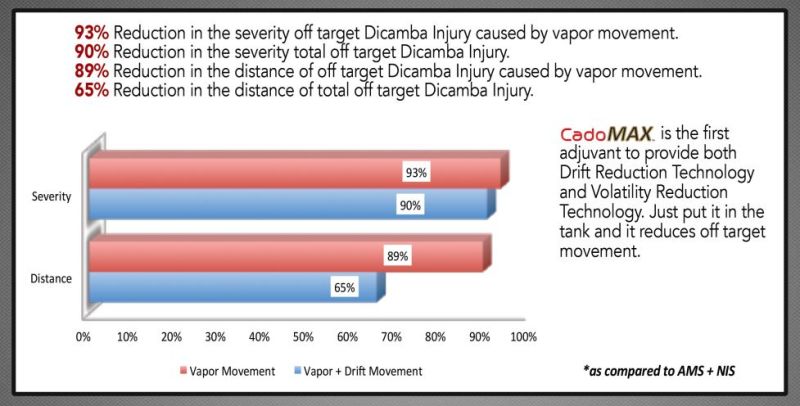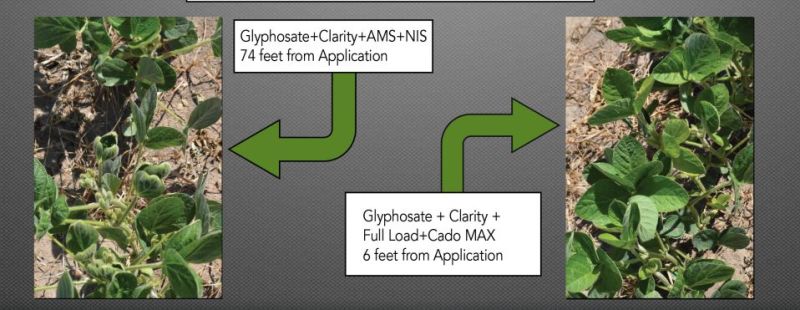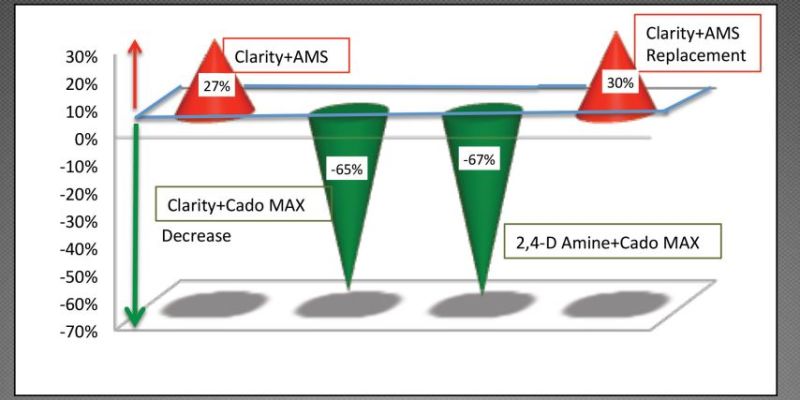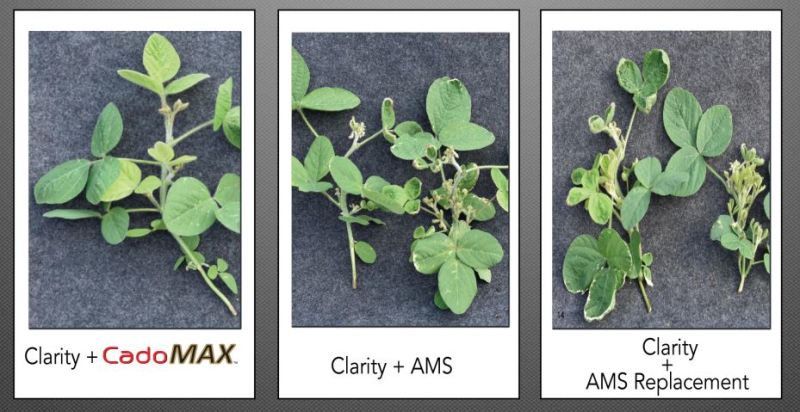Knowde Enhanced TDS
Identification & Functionality
- Agrochemical Functions
- Technologies
- Product Families
- Principal Functioning Agents
Modified vegetable oil, vegetable emulsifiers, alkyl amine ethoxylate 99.97% Constituents Inetfective as Spray Adjuvants 0.01% Total 100.00%
Features & Benefits
- Agrochemicals Features
- Product Highlights
Cado MAX™ acts as a deposition agent for use with Herbicides, Desiccants, Foliar nutrients Insecticides Fungicides, Miticides, acaricides, insect growth regulators and Plant growth regulators. Cado MAXTM induces more spray droplets into the idealsize droplets. It enhances a more accurate spray pattera by providing a more appropriate overlap. The number of fines and extra arge droplets are reduced. Proper judgment and sound application technology must always be followed when spraying pesticides. Cado MAXM acs as a volailiiv reducina aaent
Applications & Uses
- Markets
- Applicable Crop
- Application Technique
- Directions For Use
USE THIS PRODUCT ONLY AS SPECIFIED ON LABEL Cado MAXTM adjuvant can be used at rates of 1-4 pints (pts)per 100 gallons of spray mixture in most agricultural uses. Most applications with Aqueous Solution (AS, glyphosate, use rate 24 ounces/100 gallons of spray solution. Dry owables (DF) and Wettable Powder (WP) work well with 2 pts/100 gallons of spray solution. Emulsifiable Concentrate (EC) use rates can be increased to 2pts/100 gallons of spray solution. Most crops have shown excellent safety to this product. However, before treating a large area of a horticultural crop test a small area first for crop safety. NOT FOR AQUATIC USE.
- Attention
- Spray Drift Management is the responsibility of the applicator. Extreme care must be used when applying an active herbicide to prevent injury to desirable plants and crops. An active herbicide may kill, seriously injure or reduce yields of many desirable forms of vegetation including flowers, fruits, grapes, tomatoes, ornamentals, vegetables, cotton, soybeans, tobacco, beans and other desirable nontarget plants. Minute quantities of spray may cause severe plant response.
- Read and follow Spray Drift Management section of the product label. Use of a smoke generator or other means at or near the application site for the detection of air movement, air stability, or temperature inversions may be appropriate.
- SPRAY DRIFT MANAGEMENT: A variety of factors including weather conditions (e.g., wind direction, wind speed, temperature, relative humidity) and method of application (e.g.. ground, aerial, airblast, chemigation) can influence pesticide drift. The applicator must evaluate all factors and make appropriate adjustments when applying this product with an active herbicide.
- Droplet Size: When applying sprays that contain an active herbicide as the sole active ingredient, or when applying sprays that contain an active herbicide mixed with active ingredients that require a Coarse or coarser spray, apply only as a Coarse or coarser spray (ASAE standard 572) or a volume mean diameter of 385 microns or greater tor spinning atomizer nozzles.
- When applying sprays that contain multiple active ingredients that require a Medium or more fine spray, apply only as a Medium or coarser spray (ASAE standard 572) or a volume mean diameter of 300 microns or greater for spinning atomizer nozzles.
- Wind Speed: Do not apply at wind speeds greater than 10 mph. Only apply this product if the wind direction favors on-target deposition and there are not sensitive areas (including, but not limited to, residential areas, bodies of water, known habitat for nontarget species, nontarget crops) within 250 feet downwind. If applying a Medium spray, leave one swath unsprayed at the downwind edge of the treated field.
- Temperature Inversions: If applying at wind speeds less than 3 mph, the applicator must determine if: a) conditions of temperature inversion exist, or b) stable atmospheric conditions exist at or below nozzle height. Do not make applications into areas of temperature inversions or stable atmospheric conditions.
- Susceptible Plants: Do not apply under circumstances where spray drift may occur to food, forage, or other plantings that might be damaged or crops thereof rendered unfit for sale, use or consumption. Susceptible crops include, but are not limited to, cotton, okra, flowers, grapes (in growing stage), fruit trees (foliage), soybeans (vegetative stage), ornamentals, sunflowers, tomatoes, beans, and other vegetables, or tobacco. Small amounts of spray drift that might not be visible may injure susceptible broadleaf plants Avoid potential adverse effect to nontarget areas by maintaining a 100-foot buffer between the point of direct application and the closest downwind edge of sensitive terrestrial habitats (Such as grasslands, forested areas, shelter belts, woodlots, hedgerows, riparian areas and shrub lands. Follow active ingredient label(s).
- Other State and Local Requirements: Applicators must follow all state and local pesticide drift requirements regarding application of active herbicides. Where states have more stringent regulations, they must be observed.
- Equipment: All aerial and ground application equipment must be properly maintained and calibrated using appropriate carriers or surrogates.
- Additional requirements for aerial applications: The boom length must not exceed 75% of the wingspan or 90% of the rotor blade diameter. Release spray at the lowest height consistent with efficacy and flight safety. Do not release spray at a height greater than 10 feet above the crop canopy unless a greater height is required for aircraft safety. Ihis requirement does not apply to forestry or rights-of-way applications. when applications are made with a croSSwind, the swath will be displaced downwind. The applicator must compensate for this by adjusting the path of the aircraft upwind.
- Additional requirements for ground boom application: Do not apply with a nozzle height greater than 4 feet above the crop canopy.
Technical Details & Test Data
- Technical Data
Cado MAR is the first of a kind. A premier Orift Reduction adjuvant combined with NEW Volatility Reduction Technology. Its specifically designed to mininmize off target movement and redUce volatility of Glyphosate +Dicamba, and Glyphosate +24-D

CadoMAX is the first adjuvant to provide both Drift Reduction Technology and Volatility Reduction Technology. Just put it in the tank and it reduces off target movement.
- Physical Dift and Volatility Injury Comparison

- Technical Data
Increase or Decrease (Percentage) in the Amount of Volatility Injury Caused by Dicamba or 2,4-D amine Vapor from Various Treatments

- Volatility Injury Comparison

Safety & Health
- Safety
- HAZARD STATEMENT: HARMFUL IF SWALLOWED. MAY CAUSE AN ALLERGIC SKIN REACTION. CAUSES SERIOUS EYE IRRITATION. MAY CAUSE RESPIRATORY IRRITATION. VERY TOXIC TO AQUATIC LIFE. Have the product container label with you when calling a poison control center or doctor, or going for treatment. You may also contact 1-800-222-1222 for emergency medical tratment information.
- PRECAUTIONARY STATEMENT Avoid breathing mist/ vapors/ spray. Wash thoroughly with soap and water after handling. Do not eat, drink or smoke after using this product. Use only outdoors or in a well-ventilated area. Take off contaminated clothing and wash it before reuse. Specific treatment see First Aid section on this label or Safety Data Sheet. Store locked up. Dispose of contents/ container according to instructions in the Storage and Disposal section on the label.
- PERSONAL PROTECTIVE EQUIPMENT Wear protective gloves / protective clothing / eye protection/face protection.
- ENVIRONMENTAL HAZARDS Do not contaminate water by cleaning of equipment or disposal of wastes. Use this product only as specified on label.
- PHYSICAL OR CHEMICAL HAZARDS Wash LOAD OUT-CA spillage off thoroughly. The same precautions should be observed in equipment stored after use. If LOAD OUT-CA concentrate contacts clothing, flush with water
First Aid
- IF SWALLOWED Wash out mouth thoroughly with water. Get medical attention. Contact a Poison Control Center. Do not induce vomiting
- IF ON SKIN Skin Immediately flush with plenty of water while removing contaminated clothing. As soon as soap is available, wash thoroughly with soap and water. Wash clothing before reuse.
- IF INHALED None normally needed. Remove to fresh air if breathing is difficult. Give oxygen and call a physician.
- IF IN EYES Immediately flush with plenty of water for at least 15 minutes. Get medical attention.
Storage & Handling
- Storage and Disposal
Do not contaminate water, food or feed by storage or disposal. Storage: do not store at temperatures above 140°f. Disposal: wastes resulting from the use of this product may be disposed of on site or at an approved waste disposal facility. Container disposal: triple rinse (or equivalent) during mixing and loading. Recycling decontami- nated containers is the best option of container disposal. The agricultural container recycling council (acrc) operates the national recycling program. To contact your state and local acrc recycler visit the acrc web page at www.Acreccyle.Org. Decontaminated containers may also be disposed of in a sanitary landfill.

